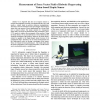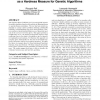1842 search results - page 53 / 369 » Measurement theory in linguistics |
IJUFKS
2000
14 years 9 months ago
2000
The concept of entropy of a discrete fuzzy measure has been recently introduced in two different ways. A first definition was proposed by Marichal [10] in the aggregation framewor...
IROS
2008
IEEE
15 years 4 months ago
2008
IEEE
—It is expected that the use of haptic sensors to measure the magnitude, direction, and distribution of a force will enable a robotic hand to perform dexterous manipulations. The...
WWW
2008
ACM
15 years 10 months ago
2008
ACM
We analyze dependencies in power law graph data (Web sample, Wikipedia sample and a preferential attachment graph) using statistical inference for multivariate regular variation. ...
CHI
2010
ACM
15 years 4 months ago
2010
ACM
This paper reports on an on-going project, which is investigating the role that location plays in the visibility of information presented on a public display. Spatial measures are...
GECCO
2007
Springer
15 years 1 months ago
2007
Springer
The Negative Slope Coefficient (nsc) is an empirical measure of problem hardness based on the analysis of offspring-fitness vs. parent-fitness scatterplots. The nsc has been teste...


